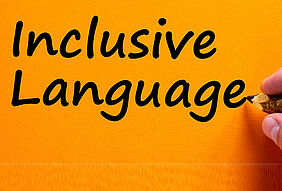Inclusive language

Therefore, we need to ensure that language evolves over the years so as to not exclude people. Inclusive language avoids biases, slang, or expressions that discriminate against groups of people based on race, gender, or socioeconomic status. CiA is committed to use inclusive language. This is also demanded especially from multi-cultural nations such as the United States of America and the European Community. Many U.S. enterprises have started already to implement the usage of inclusive language in technical documentation including handbooks, data sheets, and product descriptions. There are general guidelines for inclusive language by the Linguistic Society of America (LSA). Also, ISO provides inclusive language recommendations in its ISO House Style editing rules.
Use gender-neutral language
Use “they”, “them”, and “their” instead of “she” or “he”, “him” or “her”, and “his” or “her”. Avoid using words that are unnecessarily gender-specific; for example, write: “The chairpersons are responsible to manage the meetings” rather than “The chairmen are responsible to manage the meetings”.
| Gender-neutral (new) | Gendered (old) |
|---|---|
| business manager; executive; agent; representative (plural: business people; business community) | businessman |
| chair; chairperson | chairman |
| artisan; craftworker | craftsman |
| native country | fatherland |
| supervisor | foreman |
| person or individual | man |
| staff a project; hire personnel; employ staff | man a project |
| artificial; synthetic; manufactured; industrial; [relevant verb, e.g. made, created, caused] by human beings | man-made |
| people, humanity; human beings; the human race; men and women; homo sapiens; the public; society | mankind |
| staff; labor; workforce; personnel; workers; human resources | manpower |
| go-between, intermediary | middleman |
| first language; native language | mother tongue |
| police officer (plural: police) | policeman/men |
| spokesperson; spokesman or woman (for specific person) | spokesman |
| average or ordinary person | common man |
| meddler-in-the-middle | man-in-the-middle |
The terms “male” and “female” are sometimes used to describe electronic and mechanical connectors or fasteners. These terms should be replaced with, for example, “plug” and “socket”. CiA does this since about 20 years.
Avoid stereotype assumptions
Avoid stereotyped assumptions about the roles of men and women or people of different ages and backgrounds. For example, do not assume that a construction worker is a man or that an older person does not possess skills in using modern technology. When writing about groups of people, use language that highlights that they are individual people with specific characteristics in common rather than a group defined only by that characteristic. For example, write “people with a visual impairment” rather than “the blind and partially sighted”. Do not write, “handicapped people”, better is “people with disabilities.”
Use respectful language
Avoid terminology related to race or disparaging human rights. The terms “master” and “slaves” are misunderstood. In communication technology the term “master/slave” is used to describe a hierarchical relation. Use “commander” and “responder” in combination with node, device, and network. Use “primary” and “secondary” to substitute “master” and “slave” in conjunction with clock. The term “multi-master” is often used to describe the CAN protocol, but it does not reflect properly the CAN data link layer: Just delete it.
| Neutral (new) | Disrespectful (old) |
|---|---|
| commander/responder (node, device, network, etc.) | master/slave (node, device, network, etc.) |
| primary/secondary (clock, timer, etc.) | master/slave (clock, timer, etc.) |
| blocklist, denylist | blacklist |
| allowlist | whitelist |